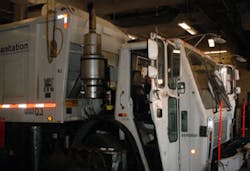The New York City Dept. of Sanitation is expecting to either retrofit its existing fleet of diesel-powered refuse trucks or replace them with EPA’s ‘07-compliant units by 2009. The refuse vehicles, which are used to collect household waste and recyclables, represent 2,200 of the Sanitation Dept.’s 6,000 vehicles.
This initiative is part of a suite of emissions-reduction legislation targeting city vehicles that was passed by the City Council on Apr. 20. Mayor Michael R. Bloomberg is expected to sign the new laws.
See New York City passes diesel emissions rules.
One notable aspect of the bills is that compressed natural gas (CNG) initiatives have been put on the back burner in favor of retrofitting existing trucks or replacing them with EPA ’07-compliant vehicles.
Rocco DiRico, Assistant Commissioner of Support Services for the Sanitation Dept., said the city’s underdeveloped CNG infrastructure, initial cost of CNG vehicles and mechanical disadvantages with the equipment have all been major hurdles in justifying a switch to CNG over ultra-low-sulfur diesel fuel (ULSD).
“The bottom line is that we were the first agency to pioneer CNG in early ’90s,” DiRico told Fleet Owner. “The diesel industry meanwhile was moving ahead at a record pace. Right now, CNG and ULSD are about equal [in terms of emissions]. The benefit of going ULSD would be, by today’s standards, there are no infrastructure or facility adjustments or technical problems [associated with CNG]. And you would get the added [environmental] benefits without the cost of crossing over.
“Right now we’re moving full steam ahead with clean diesel,” he continued. “They’ve come so far with advent of hybrid and by the time CNG catches up, I think [diesel] hybrids will be the choice… We’re also looking at hybrid technology and we intend to pursue it in the hope that it becomes the next wave for us.”
A retrofitted clean diesel refuse truck costs about $135,000, while an equivalent CNG vehicle costs over $200,000, DiRico pointed out. And in addition to the cost of building a CNG fuel infrastructure, the total cost of converting a fleet would be “tremendous” he added.
Diesel trucks in the NYC Dept. of Sanitation have been running on ULSD since July 2004, and the switch has not created any operational problems or concerns over fuel efficiency or availability. “With some older trucks there’s a lubricity issue with ULSD. But nothing in our fleet has a negative effect [since we maintain a modern fleet],” DiRico said, noting that the average age of his fleet is about 3.3 years and the replacement cycle of the fleet is seven years.
“Retrofitting doesn’t affect performance. You have to fit the right technology to the right application,” he said. “The vehicle temperature plays a big part in determining which diesel aftertreatments match your application.”
Depending on the type of aftertreatment used, retrofitting a single refuse collection vehicle can cost anywhere between $2,000 and $10,000, and can require about 16 hours of labor, DiRico said. Retrofitted vehicles will emit 90% less particulate matter.
The Sanitation Dept. has retrofitted 700 of its heavy-duty vehicles already, and plans to retrofit 200 to 300 vehicles per year, he added. And the retrofit program combined with the regular replacement cycle, which will eventually incorporate EPA 2007-complaint vehicles, DiRico hopes to see a total conversion within four years.
“We do have a ‘spare’ factor built into the fleet that allows some cushion [while some vehicles are retrofitted],” DiRico said, adding that he doesn’t expect any major service disruptions during the process. “We’re going to spread out the retrofits carefully and methodically and be wary of removing too many vehicles in a particular zone at a time.”
